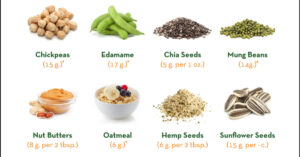Posts Tagged ‘Early Care and Education’
Quick Guide to Plant-Based Proteins
Despite the common misconception, you don’t need to rely on meat, dairy, eggs, or other animal products to reach your daily protein goals. Beans, lentils, tofu, whole grains, nuts, seeds, and meat alternatives all contain protein, and these ingredients can often be used in place of chicken, beef, pork, or fish in recipes. Eating a combination of these plant-based ingredients ensures a balanced intake of protein, fiber, and other essential vitamins, minerals, and nutrients.
Read MoreSponsor Spotlight: Michelle Buchanan of CASEWV
Michelle Buchanan serves as the Food Program Director at the Community Action of Southeastern West Virginia, a sponsoring organization of 65 family child care homes. Learn about her journey in the CACFP!
Read MoreApril Virtual Events
Back to Blog Back to Blog April Virtual Events April 1, 2025 We’re only two weeks away from the National Child Nutrition Conference in Dallas, TX. No April Fool’s pranks here! Before we see you in Dallas though, be sure to catch our next webinar on “Supporting Autism in Early Childhood Settings”. After this we…
Read MoreAutism Acceptance Month
April is Autism Acceptance Month! Our partners at Sesame Street in Communities have created new bilingual (English and Spanish) resources to help foster autistic children’s sense of creativity as well as support parents and providers in helping discover and support children’s unique perspective and personality.
Read MorePromoting Healthy Sleep Habits
As early childhood experts, you understand that sleep is not just rest—it’s foundational for healthy development in young children, and it affects everything from brain growth to emotional regulation and physical health. Well-rested children are better able to learn, concentrate, and manage their emotions which are all important for school readiness. Our partners at Child Care Aware of America have some tips to make sure those in your care are well-rested. Plus, find resources from our partners at AAP and Sesame Street in Communities!
Read MoreCACFP Operators Celebrated Nationwide
This year, National CACFP Week was formally recognized at federal, state, and local levels. Read more to learn how your peers raised awareness of the CACFP!
Read MoreCACFP Outreach
If you are a child care operator currently participating in the CACFP, congratulations! Your commitment to serving nutritious meals and snacks is crucial in fostering healthy behaviors in young children. This Mealtime Memo from our partners at the Institute of Child Nutrition highlights the benefits of the CACFP for operators, children, and families.
Read MoreSponsor Spotlight: Denise Andrews of For the Children, Inc.
Denise Andrews is CEO and Director of For the Children, Inc. which is a sponsoring organization of family child care homes in Oklahoma. Learn about her journey in the CACFP!
Read MoreLeap into Learning: Read Aloud Challenge
How often do you read aloud to the children in your care? Reading aloud to young children, particularly in an engaging manner, promotes emerging literacy and language development and supports the relationship between child and parent/caregiver.
Read MoreMovement for Healthy Bodies
Physical skills and healthy bodies can be built through everyday activities and movement. As a caring grown-up in a child’s life, you can facilitate movement and learning, and our partners at Sesame Street are here to help. Their worksheet provides fun ideas to get kids moving. Remember, there’s always an opportunity to move!
Read More









